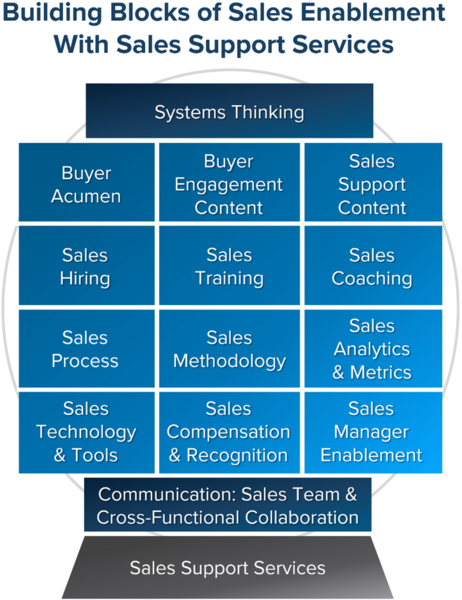ATD Blog
Selecting and Prioritizing Sales Enablement Initiatives for Impact: Part 2
Fri Aug 06 2021

Welcome back! In part 1 of this series, we discussed:
Starting with gap and impact analyses
Performance consulting
Conducting a situation assessment
Performance analysis and solution design
Now, we will start prioritizing those solutions.
Prioritization Approaches
The next step is to prioritize. Consider doing this concurrently with solution design to avoid detailing solutions that you won’t implement immediately.
Use the Sales Reengineering Chart (Figure 4) to determine the logical order of solutions based on dependencies.
Discuss the outcomes and needs from the situation assessment and the dependencies with your leadership team to tie initiatives to executive-level strategic objectives. This will help you gain buy-in, set priorities, and rank initiatives.
Figure 4: Sales Reengineering Chart (click here for a larger version)

Review the output of your situation assessment. Where on this chart does each need or required action fall?
For maximum effectiveness, work from left to right. You may consider top to bottom as well, but that’s not true in all cases. Use your best judgment given the context and the issues you’re addressing. Tackling items in this list will not be as effective as possible if you haven’t done the things to the left in an acceptable manner. (Note: I’ve only included the sales elements in the tactical column, but if you are supporting marketing and customer service or success, you can detail those elements too.)
Don’t let “perfect be the enemy of good.” Organizations that get many things 80 percent right often win over companies that obsess about perfection. Choose to obsess over a few key things, such as understanding your market, creating a buyer-centric culture, and delivering an exceptional customer experience (including the buying experience).
I didn’t mention this chart above during the situation assessment because we’re moving sequentially, but now that you’re aware of it, consider the elements in this chart as you complete your situation assessment.
Force Field Analysis
With the clarity afforded by the situation assessment and executive conversations, you can use a force field analysis to analyze the factors holding you in stasis and further illuminate how to move from point A to point B (assessing the effort and difficulty).
Document a description of the current state and the desired future state for the top issue you want to address. Use what you captured in the situation assessment to detail both states.
Assess the factors influencing progress. Start with a list of the driving forces that are supporting progress or pushing you toward your desired future state.
List the restraining forces and factors that are preventing progress toward your goal. If there is information you need to know but don’t yet (such as data, someone’s perspective, or the outcome of something that’s pending), consider that lack of knowledge a restraining force.
Assign weights to the forces. It’s a subjective exercise but is helpful. I use a one to five scale, with five being the heaviest force.
Repeat steps one through four for the remaining top-prioritized issues.
A force field analysis is only as valuable as the accuracy of the driving and restraining forces. Sometimes, it can be helpful to brainstorm “sources of forces” or use other models and frameworks to clarify your thinking.
Sources of forces to consider:
Economic
Market
Customer
Product and solution
Organization culture
Talent and expertise
Other factors from your situation assessment and performance analysis or solution design
I use my other models and frameworks to jog memories or foster thoughts, so I reference them during brainstorming to ensure I don’t miss something. Click on the links to explore images of each.
I’ll insert the building blocks here since it’s the model I use most frequently (and the four sales systems are embedded in the building blocks).

Action Planning
Now you plan the tasks in your initiative (action plans). This is where many people start without going through the above work first. It’s no wonder that so many practitioners work reactively without delivering tangible business results.
With your competed force field analysis in front of you, detail the tasks and actions you will take to:
Uncover the missing information to improve the strength and validity of your plans.
Minimize or eliminate the restraining forces.
Strengthen or add to the driving forces.
And with that, you have:
Assessed your current situation and desired outcomes
Determined the best possible solutions
Prioritized in ways that will improve the effectiveness and impact of your efforts
Developed action plans that will help you execute to achieve your desired outcomes, which will align with executive-level strategic objectives
Now, you just need to execute and reap the rewards.
For more depth on this topic:
Join me at the ATD SELL 2021 conference on October 12–13 in Las Vegas. He’ll be speaking on this exact topic on Tuesday, October 12.
Check out Mike’s new book from ATD Press, The Building Blocks of Sales Enablement, on Amazon and ATD (with a member discount). It launches in September but is available for preorder now.
Explore ATD’s certificates or programs related to this topic: Sales Enablement, Improving Human Performance, Master Performance Consultant, Needs Assessment, Consulting Skills, and Change Management.
